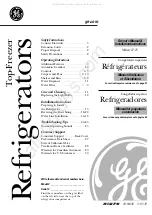
TK 56433-5-MM-EN
25
Electrical Maintenance
Alternator Diagnostic
Procedures
General Information
Poor charging performance may not be caused by a
bad alternator. The following conditions can cause
improper battery charging, even with a good alternator
(See Service Bulletin T&T 388 for more information):
•
A problem may exist in the 2A output circuit from
the alternator to the base controller or in the 2
circuit from the base controller to the battery. Check
for an open 2 or 2A circuits, fuses FS8 and FS10 if
used, loose connections, defective battery cables,
or dirty battery terminals.
•
The battery must be in good condition and capable
of accepting a charge. Check for a damaged battery,
correct electrolyte level, and loose or corroded
connections.
•
The alternator charging output will be low if the
alternator belt or pulleys are defective or the belt is
not properly adjusted. Verify the belt is not loose or
cracked and the pulleys are the correct size and in
good condition.
•
The excitation circuit (EXC circuit) must supply
voltage to the excite terminal of the alternator.
•
The sense circuit (2Y circuit) must supply voltage to
the sense terminal of the alternator.
•
The alternator must be properly grounded.
•
The unit control circuits or installed accessories
may be drawing excessive current.
•
An overcharged battery is usually caused by a
defective voltage regulator.
Alternator Identification
These units use Thermo King Alternators (
), which are painted black.
Figure 9.
Thermo King Alternator Terminal and
Component Locations
1.
B+ Terminal (Positive
Output - 2A Wire)
5.
F2 Terminal (Do Not Ground)
2.
B- Terminal (Negative
Ground - CH Wire)
6.
Voltage Regulator and Brush
Assembly
3.
S Terminal (Regulator
Sense - 2 Wire)
7.
W Terminal (AC Output)
4.
L Terminal (Regulator
Excite - 7K/EXC Wire)
Base Controller Fuse F4
The base controller has a 300 ohm resistor and a
resistor bypass fuse (F4) in the alternator excitation
circuit. The fuse and resistor are connected in parallel
and are located on the base controller. Removing the
resistor bypass fuse places the 300 ohm resistor in the
excitation circuit as required for Thermo King
alternators (and Australian Bosch alternators).
Installing the resistor bypass fuse removes the 300
ohm resistor from the excitation circuit as required for
Prestolite alternators. See the specific unit wiring
diagram for exact details.
N
No
otte
e:: The F4 fuse must be removed from the base
controller on units equipped with Thermo King
alternators. The voltage regulator on the Thermo
King alternators will be damaged if the unit is
turned On with the F4 fuse in place on the base
controller.
Test Equipment for Checking Voltage
and Current
Always use accurate test equipment such as the Fluke
23 Digital Multi-Meter and the Fluke Clamp-On
Ammeter accessory when checking alternator circuit
voltage and amperage. See the table below for Thermo
















































